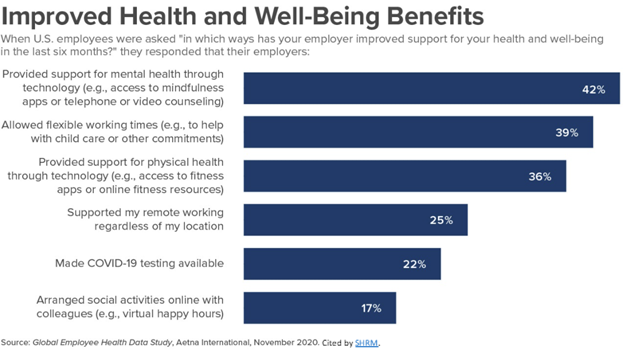
For most companies, the pandemic’s most significant and long-lasting effect has been on their people’s wellbeing. According to McKinsey,
- Seventy-five percent of employees in the United States and close to a third in the Asia–Pacific region report burnout symptoms.
- European nations are reporting increasing levels of pandemic fatigue in their populations.
- The number of those who rate their mental health as “very poor” is over three times higher than before the crisis.
Uncertainty and the demands of work and family in a crisis can carry a heavy toll. One comment, in particular, caught our attention:

Pressures like that one can bring people to despair when productivity suffers, and managers fret about getting things done. And when people lose a spouse or another loved one to the coronavirus, it can bring their world to a stop.
Employer Responses to the Pandemic
According to SHRM, employers have been stepping up with specific programs directed toward relieving the stresses of changes in work-life balance, including:
- Changes in paid and unpaid leave policies,
- Work flexibility to accommodate childcare responsibilities,
- Reimbursing work-from-home expenses, and
- Increased health and wellbeing benefits.

How Successful Companies Prioritize Wellbeing
Supporting employee health and wellbeing can significantly impact business sustainability by boosting employee engagement, recruitment effectiveness, retention, and company culture. In the 5th annual Virgin Pulse Employee Wellbeing Survey:
- 85% of companies said wellness programs support employee engagement.
- Approximately 42% of the survey respondents reported that their top reason for implementing a wellness program was to improve employee engagement.
- Respondents also reported that wellness programs had a positive effect on recruitment, retention, and company culture.

Here are some examples of how companies prioritize people’s well-being.
- PepsiCo
During the pandemic, PepsiCo has increased its pay for frontline workers, pays those who cannot work, and offers support to those employees impacted by Covid-19. Patrick McLaughlin, chief human resources officer of PepsiCo Foods North America, said that implementing such measures is essential because employees “are the backbone of our company.” - Canopy
When it found that a sudden change of circumstances, working from home, disrupted its employees’ mental and emotional state, this Utah-based company invited its employees to take part in a 30-day wellness program that focuses on physical, mental, and emotional wellbeing. - Basecamp
Basecamp reacted with a new policy when a third-party time-tracking application engaged in employee surveillance, which went against everything Basecamp believes. The policy forbids partner apps from remotely recording, monitoring, or reporting on a user’s activity other than its stated purpose. - Patagonia
Patagonia, the American retail company, closed all their stores and centers to ensure their employees’ and customers’ health and safety. They promised to pay their employees as usual during the close.
The ROI of Employee Wellbeing
A focus on employee wellness will not lower your insurance costs. Even if it makes your people healthier, the results are lost in the community-rated insurance pools. However, wellbeing delivers measurable ROI in other ways:
- Lowers employee turnover by as much as 11%.
- Improves employee engagement, driving revenue growth.
- Boosts customer service, creating more repeat business.
“The most successful organizations are now turning their attention to employee wellbeing to gain emotional, financial, and competitive advantage.”
—Tom Rath, Gallup
5 Ways to Build a Solid Employee Wellbeing Strategy
Even if your company is more concerned about surviving the pandemic than becoming this year’s industry leader, you can create a well-organized wellness strategy. Many of the actions we propose cost very little and provide a healthy return.
Here are five ways that can help your people smile and go the extra mile.
- Reinforce mental and physical health to withstand adversity
People who are mentally and physically strong are more resilient. They do not give up; instead, they rise to challenges and make their way through them. With your encouragement and support, they can develop solutions that would not surface without the challenge.
- Provide health-boosting amenities at your office like gym, comfy furniture, spatial settings for your employee to walk, stretch out, or change desks according to their comfort.
- Motivate your people to work out in the gym or go for a quick walk to refresh themselves.
- Provide healthy food and beverages.
- Train leaders to spot the signs of stress, depression, anxiety, and other mental illnesses among your employees.
- Discuss mental health issues and create a comfortable ground for people to discuss their stressors.
- Offer training in mental health.
Let your people know that all human beings struggle to attain mental wellbeing, and best solve it by sharing with people they trust—then be that person and teach others to do it.
- Make Work Meaningful to Realize Your People’s Full Potential
Make sure the work is meaningful. Meaningful work motivates and drives your people to go the extra mile to achieve goals. It helps you discover your people’s full potential and accelerates performance.
Give your people control over their work and avoid micromanaging them.
- Motivate to drive high performance
Three essentials that can help you motivate your people are value, empathy, and appreciation.
a) Value
Let people know how much you value them. Respect your people and consider their opinions. True leaders value their people and never ignore their concerns. Your people come from different backgrounds. Sometimes you may not like many of them because of their foibles. Even so, you need to break your bias and respect them.
b) Empathy
Sensing other people’s emotions can go a long way. Make some time to sit with your employees. Ask questions and listen to them. Provide the support your organization can offer. Empathizing with your people can build trust, reduce stress, and heal minds.
c) Appreciation
You can appreciate your employees when they work hard, speed up processes with innovation, support a social cause, or guide each other. Try giving them:- Fitness training opportunities
- Career development options
- The performance or appreciations awards
- Travel packages
- Extra time off
- Facilitate Consistent Communication to Build A Thriving Workforce
Clear and consistent communication is one hallmark of a healthy workplace. You and your people should regularly connect to keep the conversation going.
In “The Cost of Poor Communications,” David Grossman reported that a survey of 400 companies with 100,000+ employees cited an average loss per company of $62.4 million per year because of inadequate communication to and between employees.
In her article “Top Ten Email Blunders that Cost Companies Money,” Debra Hamilton said that miscommunication costs companies of 100 employees an average of $420,000 per year.
Train your people so they learn to communicate effectively, negotiate better, disagree agreeably, and voice their thoughts.
- Socialize to improve human connections
Human connections enhance employee morale. Socializing can help your people stay connected, encourage each other, and learn from each other.
It creates a sense of belonging, an intrinsic motivator.
Inspire your people to make meaningful connections. And soon, they become happier and more stress-free. As they socialize, they not only realize its power but their unique worth and purpose in the big picture of your business.
Annie McKee, a happiness expert, said, “one of the ways we can make ourselves happy and feel more fulfilled in our workplaces is to build friendships with the people that work with us, work for us, and even with our boss.”
Prioritize People’s Wellbeing and Let Success be Natural
When you prioritize your people’s wellbeing, work happens in an environment of mutual trust, respect, and belonging.
“We are embedding health & wellbeing at the heart of our business strategy because our people are our greatest asset, and we recognize that a healthy, happy, and committed workforce is vital to our business success.”
—Alex Gourlay, Co-Chief Operating Officer Walgreens Boots Alliance, Inc.
Phenomecloud is a full-service technology company dedicated to helping clients solve business problems, improve the capability of their people, and achieve better results.




Leave a Comment